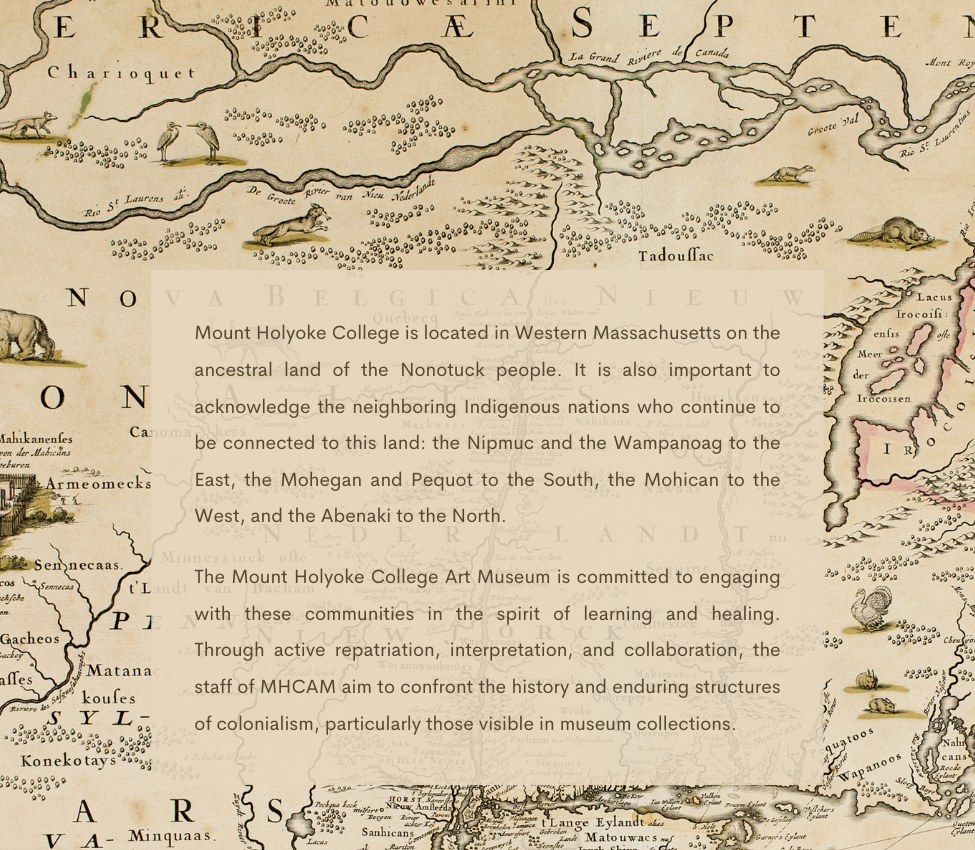Native American Graves Protection and Repatriation (NAGPRA)
The Native American Graves Protection and Repatriation Act (NAGPRA) Policy
It is the goal of the Mount Holyoke College Art Museum to work with federally recognized American Indian and Native Hawaiian communities to ensure that objects that fall under the Native American Graves Protection and Repatriation Act (NAGPRA) guidelines for unassociated grave items, sacred objects, and objects of cultural patrimony are returned to their rightful communities. To repatriate is to physically remove objects from the permanent collection and formally transfer ownership; or to formally transfer ownership and retain the objects at the Museum on long-term loan.
The process of removal and transfer shall be in compliance with all applicable local, state, and federal law. Knowledge of and adherence to the NAGPRA and all other related statutes, UNESCO convention cultural property regulations, and AAM Guidelines shall be observed. The Museum adheres to a policy of full disclosure and public transparency in all transactions.
Changes to NAGPRA regulations effective January 12, 2024 further stipulate that the Museum must obtain free, prior, and informed consent before any exhibition of, access to, or research of cultural items in the Museum’s collection and the Joseph Allen Skinner Museum at Mount Holyoke College. In compliance with this regulation, MHCAM has removed two items from view, has suspended teaching with cultural items; has temporarily closed the Joseph Allen Skinner Museum; has removed all images of these objects/belongings from its online searchable collections database until we can consult with Tribes regarding the display and research of each cultural item.
The Repatriation Process
1. The NAGPRA Committee, made up of Museum curators, educators, the Associate Director of Registration and Collections, and the Museum Director, will consult with Tribal delegates through an official claim process and identify works to be recommended and reviewed for repatriation. Based upon an incoming claim, Museum staff creates a written proposal for the repatriation of an object from the permanent collection. Additionally, faculty members and/or external scholars may be asked to substantiate the recommendation for repatriation.
2. The Associate Director of Registration and Collections will ascertain that the Museum has reasonable documentation to substantiate that it holds unrestricted title to the object and that removal does not violate any conditions made by the original donor(s), as stated in correspondence, a Deed of Gift, or the donor's will.
3. If necessary, the Museum Director will make a reasonable effort to notify the donor (or heir) of the artifacts in question regarding the proposed repatriation.
4. A list of works meeting all criteria will be presented to the Museum Director, the College Provost and Dean of Faculty, the President’s Office, and the Collections Committee of the Art Museum Advisory Board (AMAB) for review and comment. The list will include full catalogue and donor information, a summary of condition, a photograph, criteria for repatriation, citation of faculty or outside scholar opinions when appropriate, and the proposed method of repatriation. A list of objects approved for repatriation is included in the Advisory Board meeting minutes.
5. Written documentation of the justification and process of repatriation for each object shall be permanently maintained in the Museum records.
Methods of Repatriation
The following methods may be considered for repatriation:
- Physical transfer of object to claimant;
- Transfer of credit line to claimant and retention of object on long-term loan (with clearly-defined appropriate uses);
- Joint ownership of object with clearly defined parameters of use.
Questions?
Please contact Abigail Hoover, Associate Director of Registration and Collections, at ahoover@mtholyoke.edu.

 Give
Give


